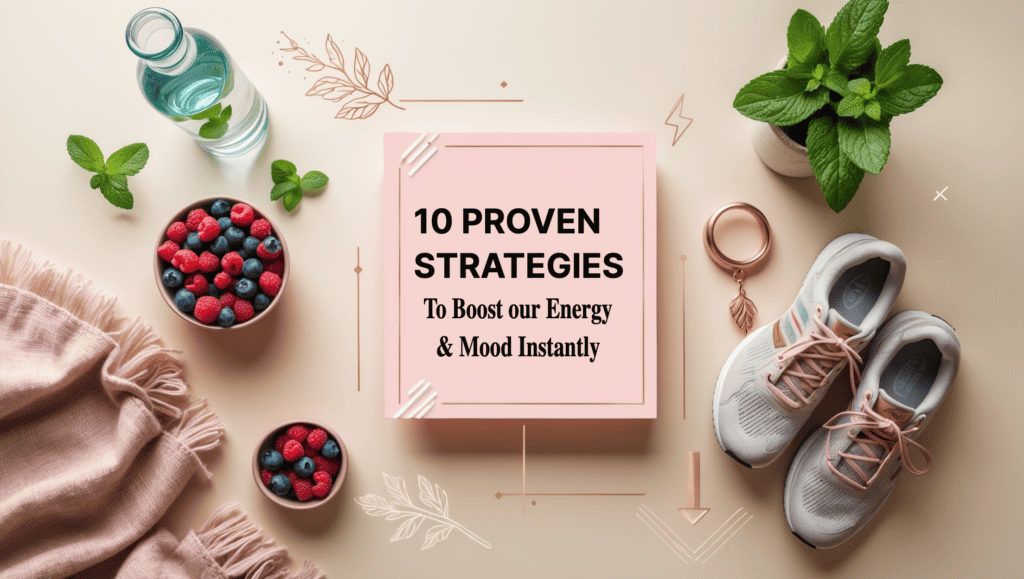
Are you constantly battling fatigue and searching for ways to feel more energetic throughout your day? We’ve all been there — that mid-afternoon slump that has you reaching for yet another cup of coffee, or that foggy morning feeling that makes getting out of bed feel like climbing Mount Everest. The good news is that boosting your energy doesn’t always require drastic lifestyle overhauls or expensive supplements! Sometimes, the most effective energy-boosting strategies are simple habits that you can incorporate into your daily routine with minimal effort.
In this article, I’m sharing my top 10 proven strategies that can help you instantly boost your energy levels and elevate your mood! These aren’t just quick fixes — they’re sustainable practices backed by science that can transform how you feel both physically and mentally. From nutrition tweaks to micro-habits that take just seconds to implement, these strategies have helped me maintain steady energy levels even during my busiest seasons. Let’s dive into these game-changing energy boosters that you can start using today!
This post may contain some affiliate links. I only recommend products and services I genuinely believe in. Additionally, some content on this website may have been created with the help of AI.
What You Might Need
- A reusable water bottle to stay hydrated
- Comfortable clothing for movement breaks
- A journal for tracking energy levels
- Healthy snacks for blood sugar stability
- A timer for work/break intervals
- Blue light blocking glasses for evening use
- A sleep mask for better quality rest
- Indoor plants for air quality and mood enhancement
1. The Science of Energy: Understanding What Drains and Boosts Your Vitality

Have you ever wondered why some days you feel like you could conquer the world, while other days just getting off the couch feels like a monumental achievement? I certainly have! Understanding the science behind our energy levels was a game-changer for me when I was struggling with constant fatigue. Our bodies are incredibly complex energy-producing machines, with countless factors influencing how energetic we feel at any given moment. Everything from the quality of our sleep to the foods we eat, the stress we experience, and even our thoughts can either fill up or drain our energy reserves.
What fascinated me most was learning how energy production happens at the cellular level through those tiny powerhouses called mitochondria. When I discovered how my daily habits were either supporting or sabotaging these microscopic energy factories, it completely changed my approach to managing my vitality. Rather than just treating the symptoms of fatigue with quick fixes like caffeine, I began addressing the root causes of energy depletion, which led to sustainable improvements in how I felt every day. This knowledge empowered me to make strategic choices that kept my energy levels stable and my mood positive throughout even the most demanding days.
The Role of Mitochondria in Energy Production
Mitochondria are the powerhouses of cells that convert nutrients into ATP, the energy currency of the body. Healthy mitochondrial function is essential for maintaining optimal energy levels.
Common Energy Thieves to Avoid
Chronic stress, inadequate sleep, dehydration, and poor nutrition are among the biggest energy drains that most people face daily.
The Mental-Physical Energy Connection
Mental and physical energy are intrinsically linked, with improvements in one area often leading to corresponding benefits in the other.
How to Track Your Personal Energy Patterns
Maintaining an energy journal can help identify your unique energy peaks and valleys throughout the day, enabling more strategic planning.
How to Maximize Your Energy Production
- Start by tracking your energy levels hourly for one week to identify patterns
- Implement a consistent sleep and wake schedule, even on weekends
- Schedule your most demanding tasks during your natural energy peaks
- Take a 5-minute movement break every 90 minutes during sedentary periods
- Optimize your workspace for energy by ensuring good lighting and air quality
- Practice stress reduction techniques during your identified energy slump times
- Gradually reduce caffeine consumption after noon
Picture This
Imagine waking up feeling naturally alert, moving through your morning with a steady stream of energy that carries you through your tasks with ease and focus. Your afternoon passes without that dreaded slump, and you finish your day still having energy to enjoy your evening activities. This isn’t just a fantasy—it’s how your body is designed to function when all your energy systems are working optimally. By understanding and working with your body’s natural energy production mechanisms, this level of consistent vitality can become your daily reality.
2. Power Up with Proper Nutrition: Fuel Your Body for Sustained Energy

When I first began my journey toward better energy management, I was honestly shocked by how dramatically my food choices affected how I felt throughout the day! The standard advice to “eat healthy” never quite clicked until I experienced firsthand the difference between an energy-draining meal and an energy-boosting one. What we eat is literally the fuel our bodies use to produce energy, yet so many of us are unknowingly making food choices that lead to energy crashes and mood swings rather than sustained vitality.
I discovered that the timing of my meals was almost as important as what I was eating. Those 3 p.m. slumps I used to battle? They practically disappeared when I started balancing my blood sugar with protein-rich meals and strategic snacking. Hydration was another revelation—even mild dehydration was sapping my energy without me realizing it! By prioritizing nutrient-dense whole foods, mindful meal timing, and proper hydration, I transformed my relationship with food from a source of temporary pleasure (followed by crashes) to a powerful tool for maintaining steady energy levels all day long.
Energy-Boosting Superfoods to Incorporate Daily
Fresh berries, leafy greens, fatty fish, nuts, and seeds provide essential nutrients that support sustained energy production throughout the day.
The Blood Sugar Balancing Act
Combining complex carbohydrates with protein and healthy fats helps prevent blood sugar spikes and crashes that lead to energy fluctuations.
Strategic Meal Timing for Maximum Energy
Eating smaller, more frequent meals can help maintain steady energy levels and prevent the energy dips that often follow large meals.
How to Create an Energy-Optimized Meal Plan
- Start your day with a protein-rich breakfast within 30 minutes of waking
- Pack portable snacks combining protein and complex carbohydrates
- Create a hydration schedule: drink 8oz of water upon waking, before each meal, and between meals
- Incorporate at least one fermented food daily for gut health
- Aim for a colorful plate with at least 3 different colored vegetables at lunch and dinner
- Limit refined carbohydrates to no more than 20% of your daily intake
- Keep a food-energy journal to identify your personal energy-draining foods
Picture This
Imagine sailing through your day with steady, reliable energy—no more mid-afternoon crashes or morning brain fog. Your plate is vibrant with colorful vegetables, lean proteins, and nourishing fats that fuel your body’s needs perfectly. Rather than reaching for sugary quick fixes or excessive caffeine, you’re nourishing your cells with exactly what they need for optimal energy production. Your meals are satisfying and sustaining, allowing you to maintain focus, productivity, and positive mood from morning until evening. This level of energetic stability is possible when you view food as your primary energy medicine.
3. Move Your Way to More Energy: Exercise as an Energy Amplifier

I know what you’re thinking—how can expending energy through exercise actually give you more energy? I was skeptical too! For years, I avoided exercise when I felt tired, thinking I needed to conserve what little energy I had. What a misconception that turned out to be! When I finally committed to regular movement, even on my most exhausted days, I discovered what seemed like a paradox: strategic exercise actually creates energy rather than depleting it. The key word here is “strategic”—the right type, duration, and timing of movement can be transformative for your energy levels.
What surprised me most was how even very short movement breaks could instantly boost my alertness and mood. Those quick 5-minute movement snacks throughout my day became non-negotiable energy enhancers that I now rely on. I found that moderate-intensity exercise generally gave me the biggest energy boost, while extremely intense workouts sometimes had the opposite effect. Everyone’s body responds differently, so paying attention to how various types of movement affect your unique energy patterns is essential for finding what works best for you. Movement truly is medicine when it comes to combating fatigue and revitalizing both body and mind.
The Exercise-Energy Paradox Explained
Regular physical activity increases mitochondrial function, improves cardiovascular efficiency, and enhances oxygen delivery to tissues, all of which contribute to higher energy levels.
Quick Energy-Boosting Movement Breaks
Short bursts of activity like jumping jacks, brisk walking, or stretching can immediately increase circulation and alertness when energy dips.
Finding Your Personal Energy-Optimizing Exercise Type
Different exercise modalities affect individuals differently—experiment with various forms to discover which provide you with the greatest energy boost.
How to Implement Energy-Boosting Movement Strategies
- Start your day with a 3-minute gentle stretching routine before checking your phone
- Schedule 2-minute movement breaks for every hour of sedentary work
- Perform 10 jumping jacks or march in place whenever energy begins to dip
- Take a 10-15 minute walk after lunch to prevent the post-meal energy crash
- Practice “exercise snacking” with brief activity bursts throughout the day
- Combine strength training with light cardio for optimal energy benefits
- Avoid high-intensity exercise within 3 hours of bedtime to prevent sleep disruption
Picture This
Imagine feeling that unmistakable surge of energy and mood elevation that comes after a brisk walk or quick stretch session. Rather than reaching for another cup of coffee or sugary snack when your energy dips, you stand up for a quick movement break and return to your tasks feeling refreshed and revitalized. Your body feels alive and vibrant throughout the day, with physical movement becoming your reliable energy booster rather than an energy drain. This dynamic relationship with exercise transforms it from something you “should do” into something you eagerly turn to when you need to amplify your energy and elevate your mood.
4. The Restorative Power of Quality Sleep: Your Energy’s Foundation
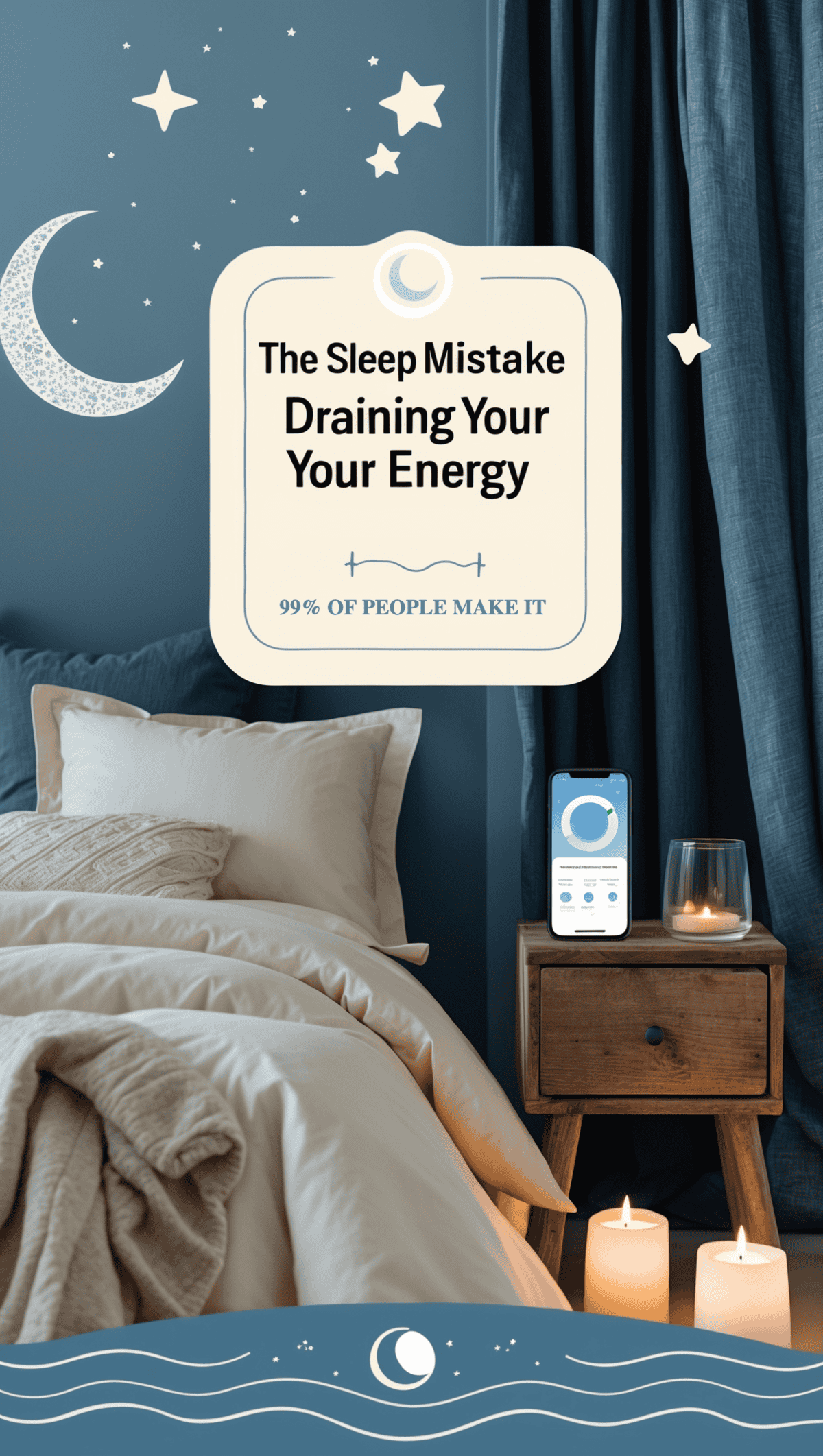
I used to wear my sleep deprivation like a badge of honor, bragging about how I could function on just five hours of sleep. What I didn’t realize was how much I was sabotaging my energy, mood, productivity, and even my long-term health! Nothing has impacted my energy levels more profoundly than prioritizing sleep quality. Sleep isn’t just rest—it’s an active time of repair and restoration that sets the stage for how you’ll feel and function during your waking hours. The connection between sleep quality and daytime energy is direct and powerful, yet so many of us compromise this essential energy foundation.
Through trial and error, I discovered that sleep consistency matters almost as much as sleep duration. Those nights when I go to bed and wake up at the same times? That’s when I feel my most energetic the following day. And creating a proper wind-down routine transformed my sleep quality more than any supplement or gadget ever did. Even when a full night’s sleep isn’t possible, strategic power napping has become my secret weapon for energy renewal. When I finally began treating sleep as a non-negotiable priority rather than a luxury, everything in my life improved—from my productivity and creativity to my mood and physical performance.
The Sleep-Energy Cycle Connection
During quality sleep, your body engages in critical restorative processes including muscle repair, memory consolidation, and hormone regulation that directly impact energy levels.
Creating Your Optimal Sleep Environment
Temperature, light, sound, and comfort all play crucial roles in sleep quality, with small adjustments often yielding significant energy benefits.
Strategic Power Napping for Energy Renewal
Short, properly-timed naps can provide immediate energy boosts without interfering with nighttime sleep patterns.
How to Optimize Your Sleep for Maximum Energy
- Establish a consistent sleep schedule with no more than 30 minutes variation, even on weekends
- Create a 20-minute wind-down routine that signals your body it’s time to sleep
- Remove all electronic devices from your bedroom or use night mode settings
- Keep your bedroom cool (65-68°F), dark, and quiet for optimal sleep quality
- Consider a white noise machine if environmental noise is an issue
- Limit caffeine after noon and alcohol within 3 hours of bedtime
- If you wake during the night, avoid checking the time to prevent anxiety
Picture This
Imagine waking up naturally, before your alarm, feeling genuinely refreshed and ready to start your day. Your mind is clear, your body feels restored, and you have steady energy that carries you through your day without significant dips. You no longer need excessive caffeine to function, and your mood remains stable and positive. When evening comes, you wind down naturally, falling asleep easily and staying asleep throughout the night. This virtuous cycle of quality sleep leading to energetic days is the foundation of sustainable vitality and is available to anyone willing to prioritize sleep hygiene and consistency.
5. Stress Management Techniques That Preserve Your Energy Reserves
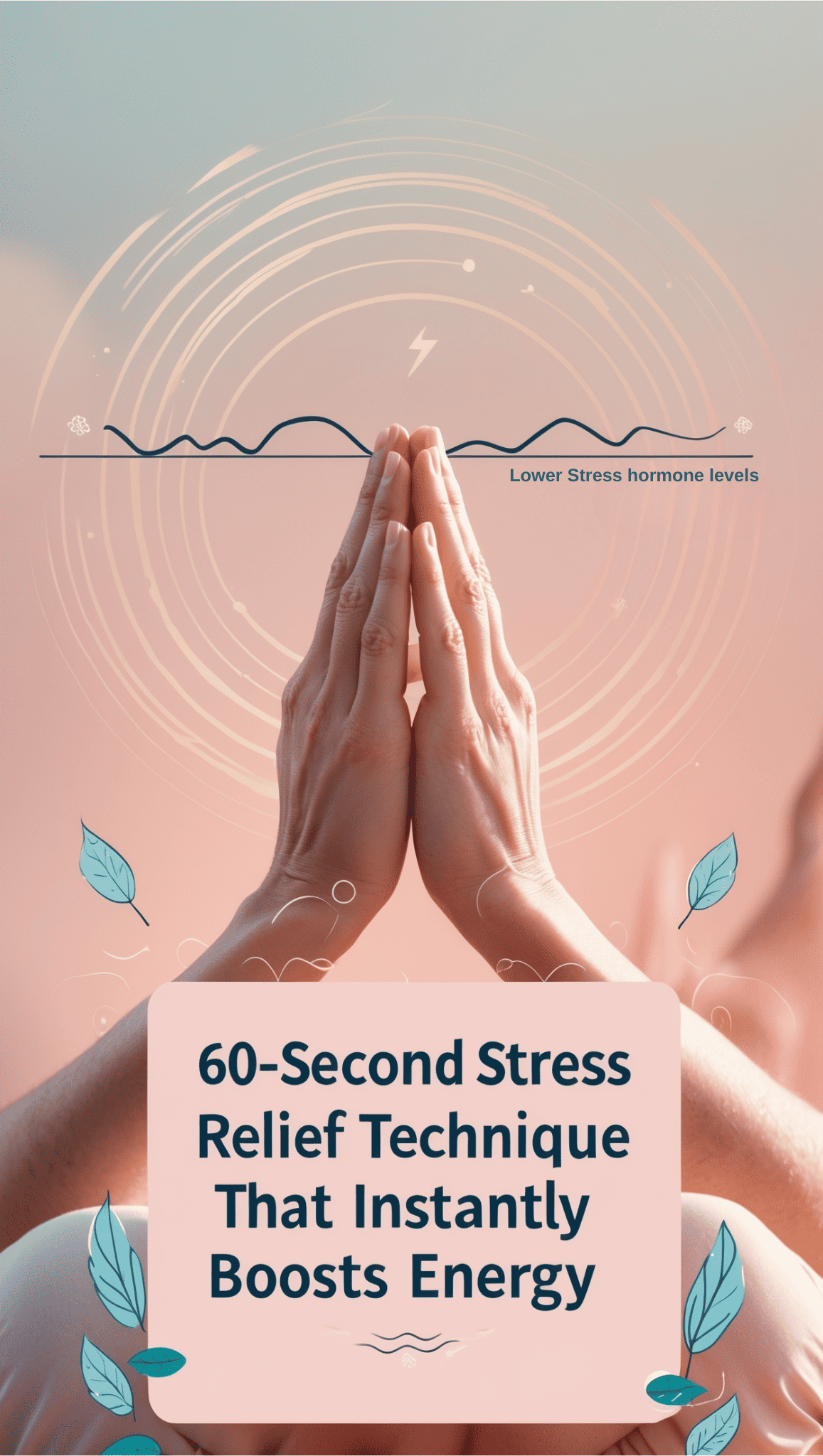
I used to think stress was just an inevitable part of modern life that we all had to endure. What I didn’t realize was how dramatically stress was depleting my energy reserves at a cellular and hormonal level! The constant cortisol spikes from chronic stress were literally draining my battery on a biological level. Learning to manage my stress response has been one of the most powerful energy preservation strategies I’ve ever implemented. It’s not about eliminating stress entirely (which is impossible), but rather about changing how we respond to stressors so they don’t deplete our precious energy.
The game-changer for me was discovering how quick stress-management techniques, some taking just 60 seconds, could interrupt the energy-draining stress cycle. Simple breathing exercises became my instant energy rescue remedy during challenging moments. Setting clearer boundaries around my time and energy was equally transformative—saying “no” more often actually gave me the energy to say a more enthusiastic “yes” to the things that truly mattered. By viewing stress management as energy management, I transformed my relationship with life’s inevitable challenges and protected my vitality in the process.
The Stress-Energy Connection Explained
Chronic stress triggers hormonal responses that prioritize survival functions over energy efficiency, leading to fatigue and reduced vitality over time.
Quick Stress-Relief Techniques for Instant Energy Recovery
Simple practices like deep breathing, progressive muscle relaxation, and brief mindfulness exercises can interrupt the stress response and preserve energy.
Energy Boundaries and How to Set Them
Identifying activities and relationships that drain versus energize you is essential for protecting your energy reserves.
How to Implement Energy-Preserving Stress Management
- Practice the 4-7-8 breathing technique (inhale for 4, hold for 7, exhale for 8) during stressful moments
- Schedule 3-minute “worry breaks” rather than letting anxiety consume you throughout the day
- Create a “stress-energy audit” identifying your top energy drains and developing mitigation strategies
- Establish clear communication templates for setting boundaries without guilt
- Implement a one-minute body scan meditation at transition points in your day
- Develop a “stress emergency kit” with sensory tools that quickly reset your nervous system
- Practice daily gratitude to shift from energy-draining negative thought patterns
Picture This
Imagine moving through your day with a sense of calm centeredness, even amid challenges and demands. When stressful situations arise, you have immediate tools to manage your response, preventing that familiar energy drain that typically follows tension. Your boundaries are clear, both with others and yourself, allowing you to preserve your energy for what truly matters. Rather than ending your day depleted and exhausted from stress, you maintain a steady energy reserve that sustains you through work, relationships, and personal pursuits. This stress-resilient state doesn’t mean avoiding life’s challenges—it means navigating them without sacrificing your precious energy in the process.
6. Sunlight and Nature: Harnessing Natural Energy Sources

I’ll never forget the dramatic difference I felt after a week-long camping trip where I was constantly outdoors. Despite sleeping on the ground and hiking daily (which should have been exhausting), I returned home feeling more energized than I had in years! This experience sparked my fascination with how natural light and outdoor environments influence our energy levels. Modern indoor living has disconnected many of us from these powerful natural energy sources, often without us realizing what we’re missing. Reconnecting with these elemental energizers—sunlight and nature—can have profound effects on our vitality.
What surprised me most was learning how morning sunlight exposure isn’t just good for mood—it actually helps regulate our entire energy cycle throughout the day by resetting our circadian rhythm. I began prioritizing morning outdoor time, even if just for 10 minutes, and noticed significant improvements in my energy levels and sleep quality. I also started bringing elements of nature indoors through plants and natural materials, creating energizing micro-environments in my home and workspace. These natural interventions cost nothing but deliver remarkable energy benefits that no supplement or energy drink can match.
Sunlight’s Role in Energy Regulation
Morning sunlight exposure helps synchronize your circadian rhythm, improving energy during the day and sleep quality at night.
The Restorative Effects of Nature Immersion
Time in natural settings has been shown to reduce mental fatigue and restore attention, leading to improved energy and focus.
Creating Energizing Indoor Nature Connections
Incorporating elements of nature into your indoor environment can help maintain energy when outdoor access is limited.
How to Harness Natural Energy Sources Daily
- Begin your day with 10-15 minutes of direct morning sunlight exposure
- Take phone calls while walking outdoors rather than sitting inside
- Position your workspace near a window with natural light when possible
- Create a mini “plant sanctuary” in your home or office with air-purifying plants
- Use your lunch break for a quick outdoor reset, even in inclement weather
- Bring natural elements indoors through materials, colors, and nature sounds
- Consider a light therapy lamp for energy support during darker winter months
Picture This
Imagine starting your day with golden morning light on your face, setting your internal clock for optimal energy throughout the day. Your home and workspace contain elements that connect you to the natural world—plants, natural materials, and plenty of sunlight. Throughout your day, you take short breaks to step outside, breathe fresh air, and reset your nervous system with nature’s calming presence. This regular connection with natural elements keeps your energy systems properly regulated, your mood elevated, and your mind clear. The natural world becomes your most reliable energy source, available whenever you need revitalization.
7. Hydration Hacks: Drink Your Way to Higher Energy Levels

Would you believe that something as simple as drinking more water could dramatically change your energy levels? I certainly didn’t until I experienced it myself! For years, I blamed my afternoon fatigue on needing more coffee, when in reality, I was chronically dehydrated. Our bodies are roughly 60% water, and even minor dehydration can significantly impact how energetic we feel. I was shocked to discover that by the time I felt thirsty, I was already experiencing the energy-draining effects of dehydration, including reduced cognitive function and physical performance.
Transforming my hydration habits wasn’t as simple as just “drinking more water”—I needed a systematic approach that worked with my busy lifestyle. Creating hydration triggers throughout my day (like drinking before meals or after bathroom breaks) helped me consistently reach optimal hydration levels. I also discovered that how I hydrated mattered almost as much as how much I consumed. Sipping water continuously throughout the day proved far more effective than gulping large amounts infrequently. And incorporating hydrating foods alongside beverages gave me a more sustainable approach to maintaining proper fluid balance and the energy benefits that come with it.
Signs of Dehydration-Related Fatigue
Headaches, difficulty concentrating, dark urine, and dry mouth are early warning signals that dehydration may be draining your energy.
Optimal Hydration Calculation for Your Body
Individual water needs vary based on body weight, activity level, and climate—a personalized approach yields better energy benefits.
Beyond Water: Complete Hydration Strategy
Electrolyte balance, hydrating foods, and strategic timing all contribute to maximizing the energy benefits of proper hydration.
How to Implement an Energy-Optimizing Hydration Plan
- Begin your day with 16oz of water before consuming anything else
- Set up visual hydration reminders or use a tracking app to ensure consistent intake
- Create a custom water bottle marking system based on your personal hydration goal
- Include electrolyte-rich foods or supplements if you’re physically active
- Incorporate hydrating foods like cucumber, celery, watermelon, and oranges
- Experiment with herbal teas and infusions for flavorful hydration alternatives
- Keep water accessible at all times—in your car, workspace, bedside, and bag
Picture This
Imagine moving through your day properly hydrated—your mind is clear, your energy is steady, and that familiar afternoon slump is notably absent. Your body functions optimally at the cellular level because it has the fluid it needs for efficient energy production. Headaches that once plagued you have diminished, and your overall sense of vitality has increased. Rather than reaching for stimulants when tired, you first consider your hydration status and address the true cause of your fatigue. This simple yet profound shift in how you approach hydration transforms it from a nagging obligation into a powerful energy management strategy you rely on daily.
8. Digital Detox: Reclaiming the Energy Drained by Technology
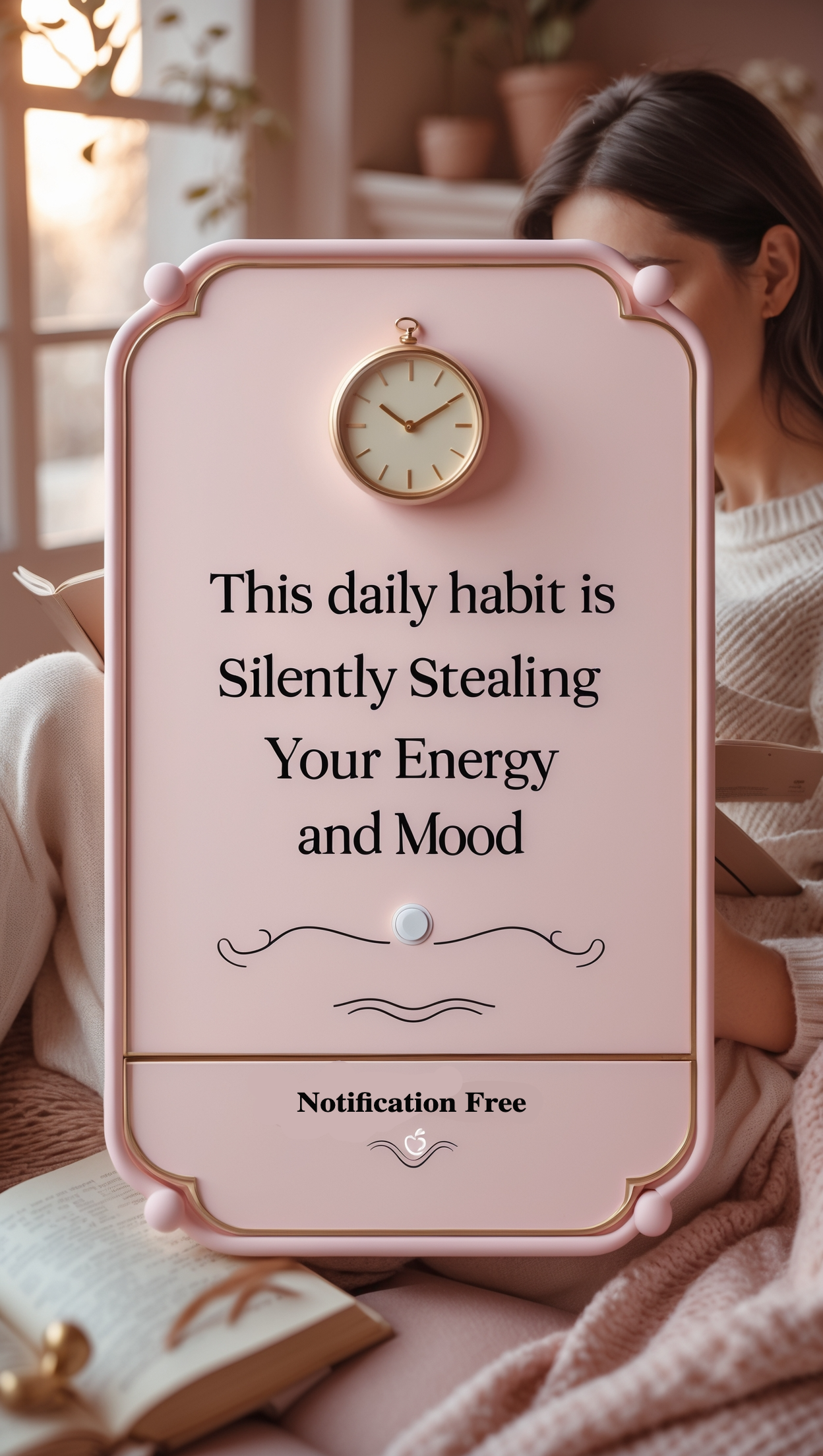
I never realized how much my devices were sapping my energy until I lost my phone during a weekend getaway. Instead of feeling disconnected and anxious as I expected, I experienced a surprising surge in mental clarity and energy! This accidental digital detox opened my eyes to how our constant connection to technology creates an invisible energy drain that accumulates throughout our day. The endless notifications, information overload, and blue light exposure all tax our nervous system and cognitive resources, leaving us depleted without understanding why.
What made the biggest difference for me wasn’t eliminating technology (which isn’t realistic for most of us) but creating intentional boundaries around my digital consumption. Setting specific tech-free times and spaces in my home became non-negotiable energy preservation strategies. I also discovered that batching my digital tasks rather than responding to every notification as it arrived preserved my mental energy and focus. By viewing my attention as a precious, limited resource rather than something to be freely given to every digital distraction, I reclaimed significant energy that I now channel into activities that truly matter to me.
The Hidden Energy Cost of Digital Overstimulation
Constant notifications, screen switching, and information processing create a significant cognitive load that depletes mental energy reserves.
Creating Tech Boundaries That Preserve Vitality
Establishing designated tech-free times and spaces helps restore mental energy and prevent the constant drain of digital engagement.
Digital Minimalism as an Energy Conservation Strategy
Streamlining digital tools and deliberately choosing which technologies add value helps eliminate unnecessary energy drains.
How to Implement an Energy-Preserving Digital Detox
- Create a morning ritual that delays checking devices for at least 30 minutes after waking
- Designate specific “notification-free” periods during your workday for deeper focus
- Implement a digital sunset 1-2 hours before bedtime to improve sleep quality
- Use airplane mode during meals and important conversations
- Conduct a digital audit to identify and eliminate unnecessary apps and subscriptions
- Create tech-free zones in your home, particularly the bedroom and dining area
- Practice “batch processing” of emails and messages rather than responding immediately
Picture This
Imagine feeling mentally clear and present throughout your day, free from the constant pull of notifications and digital distractions. Your devices serve you rather than command your attention, existing as tools that enhance your life without depleting your energy. You move through your day with extended periods of deep focus and genuine connection with others, unburdened by the cognitive load of constant digital engagement. Evening comes, and as you step away from screens, your mind naturally unwinds, preparing for restorative sleep. This balanced relationship with technology preserves your mental energy for what truly matters while still allowing you to benefit from digital tools when they genuinely serve your needs.
9. Energy-Boosting Breathing Techniques: Oxygen as Fuel

Who would have thought that something we do automatically thousands of times per day could be so poorly optimized? I certainly didn’t realize how inefficiently I was breathing until I learned proper breathing techniques that transformed my energy levels almost instantly! Oxygen is quite literally our body’s primary fuel for energy production, yet most of us breathe in shallow, inefficient patterns that limit our oxygen intake and energy potential. Learning to harness the power of breath became one of my most reliable energy-boosting strategies—one that’s available anytime, anywhere, and doesn’t cost a thing.
The most surprising discovery for me was how quickly certain breathing techniques could shift my energy state. When I feel an afternoon slump coming on, a few minutes of energizing breathwork now works better than caffeine for revitalizing my focus and alertness. I’ve collected a toolkit of different breathing techniques for various energy needs—some that calm and center me when I’m feeling scattered, others that energize me when I’m feeling sluggish, and still others that help me transition between different activities throughout my day. This simple yet profound practice has become my most reliable method for managing my energy states at will.
The Science of Breath and Energy Production
Proper breathing increases oxygen delivery to cells, enhancing mitochondrial function and ATP production—the body’s primary energy currency.
Energizing vs. Calming Breathing Patterns
Different breathing techniques produce distinct physiological effects, allowing you to strategically shift your energy state as needed.
Nostril Breathing for Energy Regulation
Alternate nostril breathing and other yogic techniques help balance the nervous system and optimize energy flow throughout the body.
How to Implement Energy-Boosting Breathing Practices
- Start your day with 10 box breaths (inhale, hold, exhale, hold for equal counts)
- Practice the energizing “breath of fire” technique for 30 seconds when energy dips
- Use the 4-7-8 breathing method during transitions between activities
- Try alternate nostril breathing to balance energy when feeling uneven or scattered
- Implement “breath awareness breaks” by setting hourly reminders to check breathing patterns
- Practice diaphragmatic breathing while waiting in lines or during commutes
- Create breath “anchors” throughout your day—before meals, when entering a new space, etc.
Picture This
Imagine having a reliable energy management tool available to you at all times, regardless of where you are or what you’re doing. With just a few intentional breaths, you can shift from a state of fatigue to alertness, or from scattered thoughts to focused attention. Your breath becomes your most trustworthy energy regulator, allowing you to navigate the demands of your day with greater resilience and vitality. Rather than being at the mercy of energy fluctuations, you actively influence your energy state through this simple yet powerful practice. This level of energy autonomy transforms how you experience your day, empowering you to show up as your most energetic self when it matters most.
10. The Power of Social Connection: Relationships That Energize

Have you ever noticed how some people leave you feeling energized and uplifted, while others seem to drain every ounce of your vitality? This phenomenon fascinated me as I worked on optimizing my energy management. The science behind it is clear: social interactions have a direct impact on our hormones and nervous system, either enhancing or depleting our energy reserves. What surprised me most was discovering that introversion or extroversion isn’t the determining factor—it’s the quality and nature of the interactions that matter most for energy exchange.
Taking inventory of my social connections was eye-opening! I began categorizing relationships as either “energy-giving” or “energy-draining” and adjusting my boundaries accordingly. This didn’t mean cutting people out of my life, but rather being more strategic about when and how I engaged with different individuals based on my energy needs. I also discovered the vital importance of community for sustained energy and wellbeing. Even as someone who values alone time, I found that the right kind of social connection acted as a powerful energy amplifier in my life. Building and nurturing these positive connections became an essential part of my energy management strategy.
The Neurochemistry of Energizing Connections
Positive social interactions trigger the release of energy-enhancing hormones like oxytocin, dopamine, and serotonin that counteract stress hormones.
Identifying Energy Vampires vs. Energy Catalysts
Learning to recognize which relationships deplete or enhance your energy allows for more strategic social engagement.
Creating Community for Sustained Vitality
Regular connection with supportive communities provides energy benefits that extend far beyond the immediate interaction.
How to Cultivate Energy-Enhancing Relationships
- Conduct a “relationship energy audit” to identify which connections energize versus drain you
- Schedule time with energy-giving people before challenging tasks or during typical low-energy periods
- Create and practice boundary scripts for limiting time with energy-draining individuals
- Join or create a community centered around activities that naturally energize you
- Practice energy-aware socializing by checking your energy levels before and after interactions
- Schedule regular micro-connections with positive people, even if just for 5-minute check-ins
- Build in recovery time after socially demanding events, particularly if you tend toward introversion
Picture This
Imagine surrounding yourself with relationships that leave you feeling more energized than before the interaction. Your social calendar is thoughtfully curated with connections that inspire, motivate, and revitalize you. You’ve established clear, healthy boundaries with people who tend to drain your energy, and you’ve cultivated a supportive community that provides a sense of belonging and reciprocal energy exchange. Rather than feeling depleted after social engagements, you find yourself energized and uplifted. This intentional approach to relationships transforms your social life from an energy expense into an energy investment that pays dividends in increased vitality, creativity, and joy.
Want to Simplify Your Wellness Journey?
Feeling overwhelmed by all these energy-boosting strategies? Let me help you with my Wellness Lifestyle Strong Foundation Consultation! This comprehensive audit examines your current wellness practices, including energy management and mood enhancement, identifying strengths and gaps that impact your overall well-being. During our session, I’ll guide you through a thorough assessment of your lifestyle habits, health concerns, and wellness aspirations to create a truly customized approach.
The audit includes a pre-session questionnaire to gather baseline information, a 90-minute consultation where we’ll meticulously evaluate your current wellness foundation, and personalized recommendations based on our findings. I’ll help you prioritize which practices deserve immediate attention (like the energy-boosting techniques from this article), create realistic implementation timelines that respect your schedule, and adapt evidence-based strategies to fit your unique circumstances. You’ll leave with a clear understanding of your wellness starting point and a strategic roadmap for building a sustainable, personalized practice. Ready to establish a strong foundation for lasting wellness? Book your Wellness Lifestyle Strong Foundation Consultation today and let’s transform your approach to health and wellbeing!

Personalized Wellness Plan Development
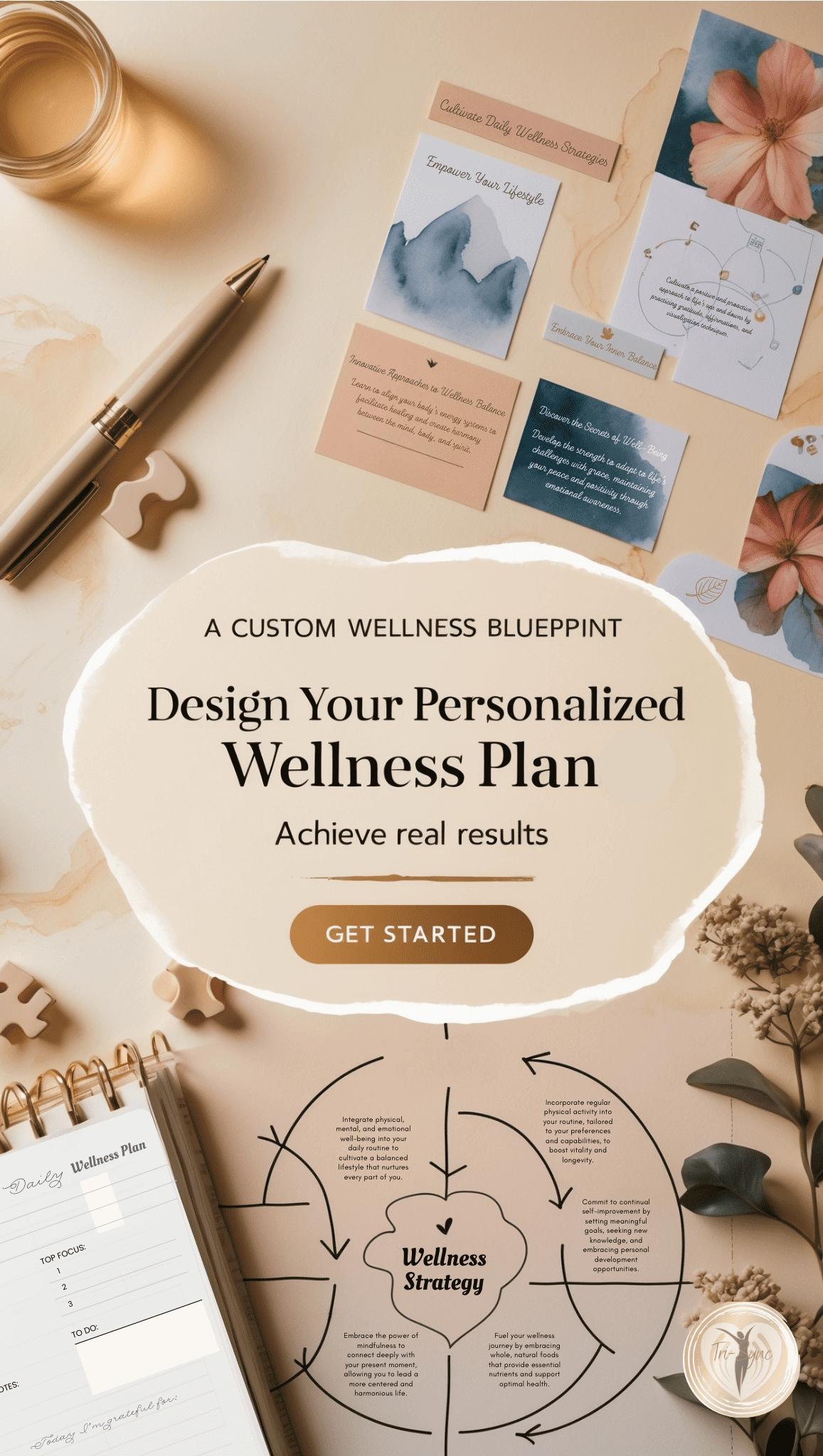
Final Thoughts
Energy management is truly the foundation upon which everything else in our lives is built. When our energy is depleted, even the simplest tasks feel overwhelming, our mood suffers, and our ability to show up as our best selves diminishes. By implementing these ten strategies—understanding energy science, optimizing nutrition, incorporating strategic movement, prioritizing quality sleep, managing stress, connecting with nature, staying properly hydrated, creating digital boundaries, utilizing breathwork, and cultivating energizing relationships—you create a comprehensive system for sustainable vitality that goes far beyond quick fixes.
What I love most about these approaches is their interconnected nature. Improvements in one area often create positive ripple effects in others. Better sleep leads to better stress management, which supports more consistent exercise, which enhances sleep quality—creating an upward spiral of increased energy! Start by choosing just one or two strategies that resonate most strongly with you, and gradually incorporate others as they become habitual.
Remember that energy management isn’t about pushing yourself to do more or be more productive. Rather, it’s about honoring your body’s needs and creating the conditions for natural vitality to flourish. Your energy is your most precious resource—it determines the quality of your work, relationships, and overall life experience. By treating it with the respect and attention it deserves, you unlock your full potential for a vibrant, energetic life filled with possibility.
Which energy-boosting strategy will you implement first? I’d love to hear about your experiences as you put these practices into action!
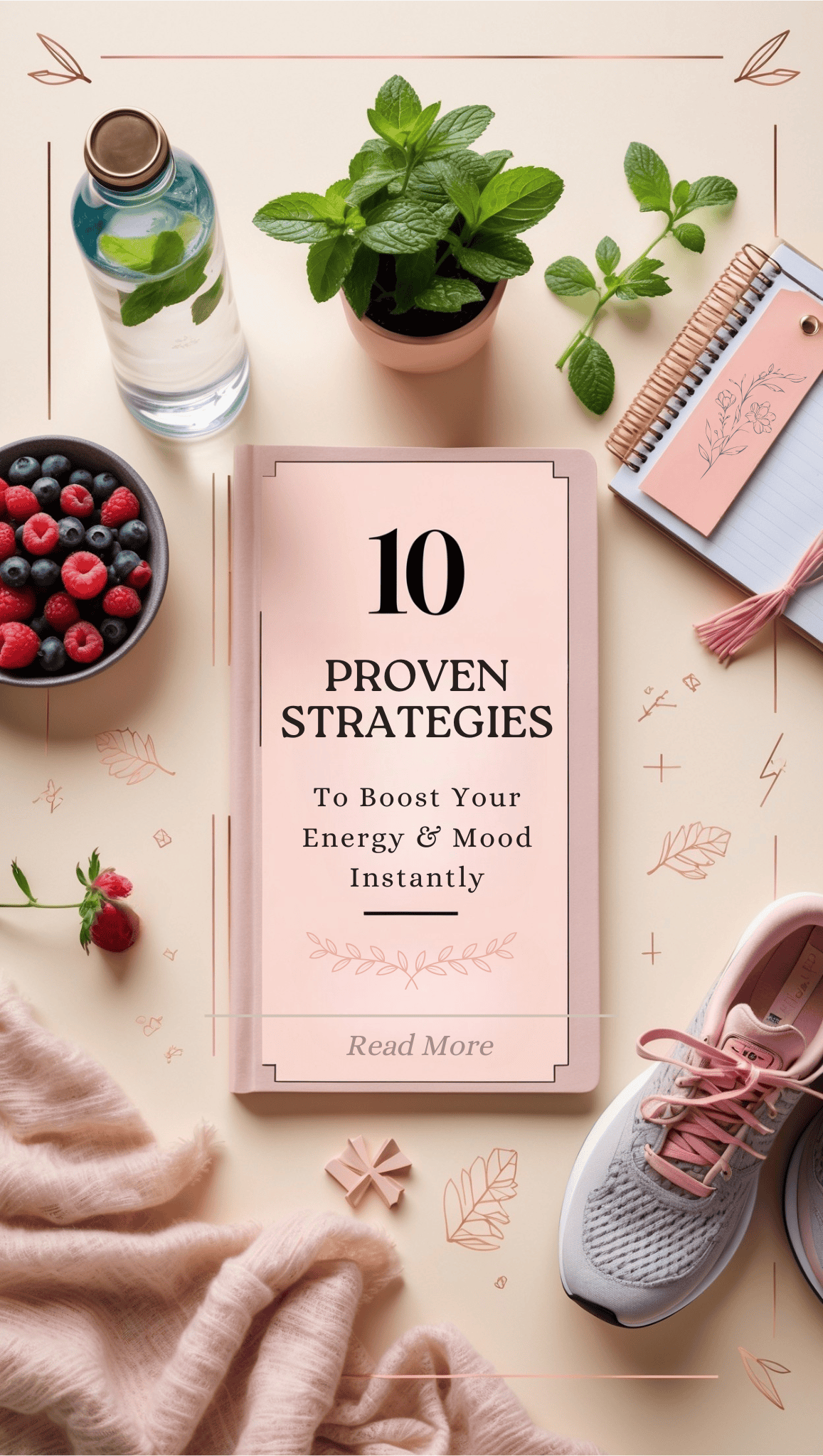
This post may contain some affiliate links. I only recommend products and services I genuinely believe in. Additionally, some content on this website may have been created with the help of AI.
FREQUENTLY ASKED QUESTIONS
How quickly can I expect to see improvements in my energy levels?
Some energy-boosting strategies can provide almost immediate benefits, particularly breathwork, hydration, and short movement breaks. You may notice improvements in alertness and focus within minutes of implementing these techniques. Other approaches, like optimizing sleep patterns and nutrition, typically show cumulative benefits over days or weeks as your body’s systems recalibrate. Most people report noticeable improvements within 1-2 weeks when consistently applying several strategies together, with continued enhancements over several months as these practices become habitual.
Do I need to implement all ten strategies to see significant energy improvements?
Absolutely not! While these strategies work synergistically, even implementing just one or two consistently can yield noticeable energy benefits. Start with the approaches that seem most relevant to your particular energy challenges or those that feel most accessible given your current lifestyle. For many people, sleep optimization and hydration provide the quickest return on investment, but your experience may differ based on your unique situation. The key is consistency with whatever strategies you choose rather than trying to overhaul everything at once.
Is it normal to experience energy fluctuations throughout the day, even when following these strategies?
Yes, natural energy fluctuations are a normal part of your body’s circadian rhythm. Even with optimal energy management, most people experience some variation in their energy levels throughout the day. What these strategies help with is smoothing out the extreme peaks and valleys, preventing severe energy crashes, and raising your baseline energy level overall. Rather than eliminating natural fluctuations entirely, effective energy management works with your body’s natural rhythms to ensure more consistent and sustainable energy levels.
How do I know if my fatigue requires medical attention rather than lifestyle adjustments?
While the strategies in this article help address common energy challenges, persistent fatigue sometimes signals underlying medical conditions that require professional attention. Consider consulting a healthcare provider if you experience extreme fatigue that doesn’t improve with lifestyle changes, sudden or severe fatigue without apparent cause, fatigue accompanied by other symptoms like unexplained weight changes or persistent pain, or fatigue that significantly impacts your daily functioning despite adequate sleep. These may indicate conditions like anemia, thyroid disorders, sleep apnea, or other health issues that benefit from medical treatment alongside lifestyle optimization.
Can these energy-boosting strategies help with chronic fatigue syndrome or similar conditions?
These strategies can be valuable supportive measures for those with chronic fatigue syndrome (CFS), fibromyalgia, or similar conditions, but they should be implemented as part of a comprehensive treatment plan developed with healthcare providers. Individuals with these conditions often need to modify approaches, particularly around exercise, which may temporarily worsen symptoms if not carefully calibrated. Gentle pacing, energy conservation, and working with specialists familiar with these conditions is essential. Many patients find that sleep optimization, stress management, and nutritional approaches provide some relief when appropriately tailored to their specific needs and limitations.
About The Author
Jahlila is a Transformational Whole Self and Wellness Lifestyle Empowerment Coach, a devoted mother, passionate writer, and a fervent advocate for holistic wellness. She is the creator of The Tri-Sync Method, a comprehensive coaching program designed to help women establish a personalized wellness and self-care lifestyle for enduring total health wellness.
Her journey has transitioned from focusing solely on health and fitness to embracing a broader mission: empowering women through holistic approaches that unite body, mind, and spirit. Jahlila is dedicated to teaching, coaching, writing, and speaking about how wellness intersects with a joyful, balanced life. Her mission is to motivate women to prioritize and achieve their wellness goals, fostering a deep connection between a vibrant lifestyle and true happiness. Ready to reclaim your vitality, achieve mental clarity, and embrace your wellness journey? Explore more at The Tri-Sync Method.Com
Don’t wait another day to start living your healthiest, happiest life. Schedule a Free Discovery Consultation with Jahlila today to explore how The Tri-Sync Method can transform your life. For additional questions or personalized guidance, please visit our Contact Page.




Leave a Reply